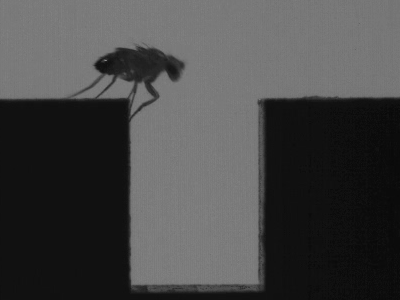Flies can cross gaps wider than their body size. They use a sophisticated sequence of movements to do this.
What?
Fruit flies (Drosophila melanogaster) can overcome obstacles in their path by means of a complex movement behaviour. This special behaviour is adapted to the width of the gaps and the animals can cross gaps of more than 4 mm with a body size of approx. 2.5 mm. On the one hand, the movement sequence is sufficiently stereotyped and constant to be easily identified and analysed. On the other hand, it is also flexible enough to be able to detect and analyse a large number of different deviations. For example, there are flies that attempt to climb in gaps that cannot be crossed or that orientate their climbing attempts incorrectly.
How?
We use a variety of different techniques and methods to study this behaviour of flies - from high-speed videography with several hundred images per second to state-of-the-art genetic methods.
Why?
The climbing behaviour of Drosophila offers itself as a platform for investigating a wide range of questions where simpler behavioural experiments have too low a resolution.
Publications
A screen for constituents of motor control and decision making in Drosophila reveals visual distance-estimation neurons
Triphan T, Nern A, Roberts SF, Korff W, Naiman DQ, Strauss R.
Sci Rep. 2016 Jun 3;6:27000.
DOI: 10.1038/srep27000
Visual targeting of motor actions in climbing Drosophila
Triphan T, Poeck B, Neuser K, Strauss R.
Curr Biol. 2010 Apr 13;20(7):663-8.
DOI: 10.1016/j.cub.2010.02.055
